Vertebrate Palaeontology collection
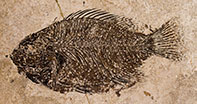
(Photo: Birgitte Rubæk)
Curator
Collection manager
Temporarily without collection manager
About the collection
The Vertebrate Paleontology collection covers all vertebrate specimens from when vertebrates first appear in the Cambrian period (541 million years ago) and until the Quaternary period (2.6 million years ago). Quaternary vertebrates are stored in the Quaternary collections. The VP collection comprises some 18,000 specimens, predominantly fish from the Silurian, middle and late Devonian, late Permian, early Triassic, and the Cretaceous/Paleogene boundary. Major taxa represented are mainly agnathans (Agnatha, jawless fish), placoderms (Placodermi, armored fish), acanthodians (Acanthodii), elasmobranchs (Elasmobranchii, sharks and rays), actinopterygians (Actinopterygii, ray finned fish), dipnoids (Dipnoi, lung fish), and porolepiformes, osteolepiformes and coelacanths (lobe-finned fish). They mainly derive from deposits in North and East Greenland and Denmark.
Apart from the fishes and sharks mentioned above, the collection contains the very important early tetrapod fossils (early four-legged vertebrates) Ichthyostega and Acanthostega, from late Devonian deposits in East Greenland; late Triassic vertebrates from east Greenland (dinosaurs, phytosaurs, and mammals); a large collection of predominantly ray-finned fish with some birds and turtles, from the earliest Eocene marine diatomite deposits of the Limfjord area in Jutland, Denmark; and finally a representative collection of cetacean fossils from the Oligocene and Miocene deposits in the South-Western parts of Jutland, Denmark.
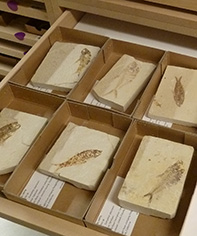 Vertebrate Palaeontology collection in numbers
Vertebrate Palaeontology collection in numbers
- Number of specimens: 18,595
- Types: Unknown
- Digitally available specimens: All
- Percentage digitized: 100 %
Strengths
Denmark is not very rich in vertebrate fossils, but as the national museum within natural history, we do have a strong representation in our collection (mainly sharks, lobe- and ray-finned fish, a few birds, and some cetaceans).
Other museums worth noting in connection with collections of Danish vertebrate fossils are the Fossil- and Mo-clay Museum, and the Fur Fossiler Museum, both in Northern Jutland; and the Museum Sønderjylland Gram Claypit - Palæontology in South Jutland.
The Danekræ fossil trove collection also contains vertebrate fossils of unique scientific or exhibitional value. Since 1990, when the fossil trove (“Danekræ”) national museum law was implemented, all fossils of unique scientific value found in Denmark belong to the Danish State and are kept in a separate Danekræ collection.
We act as the national depository for all Greenlandic fossils. This makes our Greenlandic collection the world’s finest. It is therefore worth noting that everything excavated from 1991 and onwards belongs to the Greenland National Museum and Archives. All work on these fossils will therefore require a written consent from the director or deputy.
Important subcollections/specimens/pieces/collectors
Lower and Upper Silurian, and Lower Devonian microfossil assemblages of jawless fish (Agnatha, Thelodonti and Anaspida) from Hall Land, North Greenland.
Very large and substantial collections of Late Devonian fossils from East Greenland, including several holotypes: armoured fishes Arthrodira (Homostius, Phyllolepis and Groenlandaspis among others) and Antiarchi (Asterolepis, Bothriolepis and Remigolepis a.o.), lungfish (Dipnoi: Jarvikia, Soederberghia a.o.), lobe-finned fishes (Porolepiformes: Glyptolepis and Holoptychius a.o. and Osteolepiformes: Gyroptychius, Eusthenodon) and early tetrapods (including the type specimens of Ichthyostega and Acanthostega).
Upper Carboniferous freshwater fishes from the Kong Oscars Fjord area, East Greenland, especially Acanthodian (Acanthodes, Traquairichthyes) and Palaeonisciformes (Aldingeria, Whiteichthys).
Lower Permian freshwater fossils from Profilfjeldet, East Greenland including sharks (Pleuracanthidae), acanthodian (Acanthodes) and palaeonisciform fishes (Aldingeria, Whiteichthyes) and stegocephalian remains.
A significant Upper Permian marine vertebrate assemblage from across the Foldvik Creek Formation deposits of East Greenland, which consists of sharks (Elasmobranchii, including Arctacanthus, Erikodus, Fadenia, Sarcoprion and Janassa a.o.) and ray-finned fishes (Actinopterygii, including Elonichthys, Pygopterus, Palaeoniscus, Boreolepis, Acropholis and Plegmolepis a.o.).
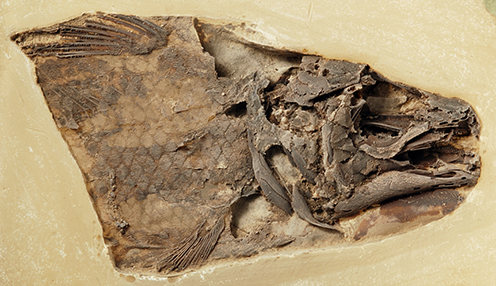
Head and front body of the coelacanth fish Whiteia from the Eotriassic of East Greenland (specimen NHMD 152923)
Very large and substantial collections with several holotypes of earliest Triassic (“Eotriassic”) fossils from Clavering Ø, Kap Stosch, Kap Franklin, Traill Ø, and Mester Vig; all East Greenland. The vertebrate groups present include sharks (Elasmobranchii: Polyacrodus and Parahelicampus); lobe-finned fishes (Coelacanthiformes: Laugia, Whiteia, Sassenia); ray-finned fishes (Boreosomus, Pteronisculus, Australosomus, Birgeria, Bobasatrania, Perleidus, Helmolepis, Ospia and Broughia a.o.); and a number of amphibians (Temnospondyli: Wetlugasaurus, Stoschiosaurus, Lyrocephalus and Tupilakosaurus).
A varied collection of Late Triassic vertebrate fossils from Jameson Land, East Greenland, containing, amongst others, the type specimens of the mammal Haramiyavia clemmenseni, and the small pterosaur Eudimorphodon cromptonellus. The vertebrate assemblage also contains semi-aquatic phytosaurian reptiles, early proganochelyid tortoises, the plant-eating dinosaur Plateosaurus, as well as large numbers of cheirothere and dinosaur tracks and trackways.
Diverse assemblages of Cretaceous and Tertiary shark teeth and microteeth assemblages documenting the Cretaceous-Paleogene transition from marine deposits in eastern and northern Denmark.
An extremely well-preserved lowermost Eocene vertebrate fossil assemblage from marine deposits in the Limfjord area, North Jutland, especially ray-finned fishes (Actinopterygii: Rhamphosus, Rhinocephalus, Palaeocentrotus, Heterosteoglossum, Xosteoglossid, Brychaetoides, a.o.); sea turtles (Testudines: Tasbacka a.o.), sea snakes (Palaeophidae: Palaeophis); and birds (Neornithes: Lithornis, Eocypselus, Septentrogon a.o.).
Upper Miocene whales (Mysticeti: Plesiocetus, Tranatocetus a.o.) from the Gram deposits of South Jutland.
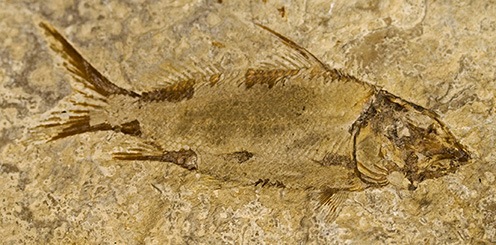
(Photo: Birgitte Rubæk)
History
The oldest specimens in the collections go back to the 18th century. They were collected by the Dutch naturalist and pharmacist Albertus Seba (1665-1736) and bought by the Danish count Adam Gotlob Moltke (1710-1792) in 1762. They remained as part of the Moltke family’s private collection until 1810 when they were donated to the University of Copenhagen by count Joachim Godske Moltke (1746-1818), son of A.G. Moltke.
Throughout the 1800’es and first half of the 1900’es, there was no tenured lecturer of vertebrate palaeontology at the University of Copenhagen. Thus additions to the fossil vertebrate collection only happened intermittently, and most acquisitions were smaller collections of non-Danish exemplar specimens for teaching purposes. However, mention should be made of a number of Oligocene and Miocene cetacean fossil remains from southeast Denmark, which were studied, described and accessed into the collections in the early part of the 1900’es.
This state of the collections was to change from the early 1930’es and onwards, when the University of Copenhagen’s fossil vertebrate collections received a series of substantial and important collections.
During Lauge Koch’s Three Year Expedition to East Greenland in 1931-1934, and then again in 1936, a team led by Swedish paleontologist, Gunnar Säve-Söderberg (1910-1948), brought back some of the most important and revolutionizing fossils: the then earliest known tetrapods, Ichthyostega and Acanthostega. These fossils derived from the Upper Devonian deposits along with several other fossils, mainly armoured placoderms, lobefin and lungfishes. The expeditions to East Greenland also recovered several important fossil fish and elasmobranch assemblages from the Carboniferous, Permian and lowermost Triassic.
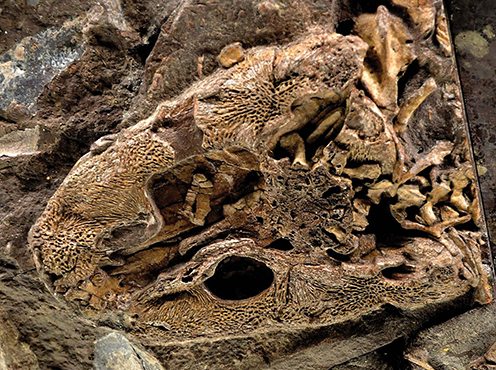
Skull of the early tetrapod Acanthostega
The Carboniferous and earliest Triassic fishes were described by Eigil Nielsen (1910-1968), who became the first formally trained and tenured Danish vertebrate palaeontologist at the museum. The earliest Triassic fishes in particular document the fauna during the important period immediately following the worst mass extinction event in Earth’s history, at the end of the Permian period 251 million years ago. Other elements described from the early Triassic includes temnospondyl amphibians, described by Säve-Söderbergh and Nielsen.
The fossil fishes from Greenland were supplemented by a significant collection of similar-aged earliest Triassic fossils from Madagascar, collected by Nielsen in 1953.
Further expeditions in cooperation with Swedish researchers to East Greenland in the 1950’es recovered more fossils from the Devonian and Permian, including more early tetrapods, as well as important shark and fish specimens. Studies of the Permian and Triassic elasmobranchs from Greenland had begun by Eigil Nielsen in the 1930’es to 1950’es, and was continued by his student and eventual successor Svend Erik Bendix-Almgreen (1932-2004) from the 1960’es and onwards.
Exquisite lowermost Eocene fossils of especially fishes had long been known from marine diatomite deposits in the Limfjord area of Northern Denmark. A local initiative established a small museum in 1953; today known as Fur Fossiler Museum. A good report was quickly established with the Eigil Nilsen and the Geological Museum in Copenhagen, and a formalized, ongoing cooperation was established from 1961 onwards. Throughout the years, more and more fossils have been recovered, documenting the marine fauna of the North Sea Basin during the Paleocene-Eocene greenhouse transition event. In addition to numerous fishes, exceptionally preserved birds and sea turtles contribute to the collections. Nowadays, fossils from the Paleocene-Eocene deposits make up the brother’s share of vertebrate fossils registered as Danekræ fossil trove.
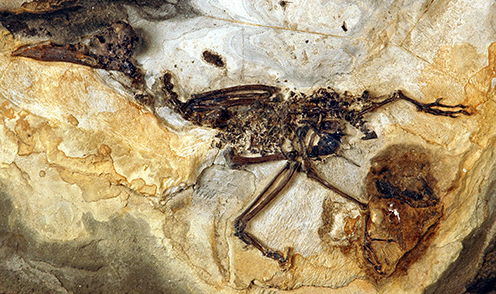
Complete skeleton of the roller-like bird Septencoracias morsensis from the Eocene Fur Formation of Denmark (specimen NHMD 74730; photo by Sten L. Jakobsen)
During the 1970’es a number of fossil whales were recovered and excavated from the late Miocene deposits in South Jutland under the supervision of Bendix-Almgreen. This fossil finds would lead to the establishment in 1978 of a local museum for natural history and palaeontology in the town of Gram; today known as the Museum Sønderjylland Gram Clay Pit - Palaeontology.
Expeditions in search of, and studies of the Devonian tetrapod material underwent a renaissance beginning in the late 1980’es, as material in the Copenhagen collections was re-studied by professor Jennifer Clack (1947-2020) of Cambridge University and colleagues.
In the late 1980’es and early 1990’es a series of expeditions to Jameson Land in East Greenland in close collaboration with professor Farish Jenkins (1940-2012) of Harvard University led to the recovery of a diverse assemblage of vertebrate fossils, including dinosaurs, pterosaurs, turtles and early mammals. This effort was renewed in 2012 by an expedition led by Geocenter Møns Klint, which recovered additional, substantial fossil vertebrate material. These fossils are formally registered with the Greenland National Museum and Archives through the Natural History Museum of Denmark.
Since 2000, some recent research involving specimens from the fossil vertebrate collection include taxonomic studies of lowermost Eocene birds; the discovery and description of fossil melanosomes in fossil bird feathers; and latest Cretaceous and earliest Tertiary shark macro- and microteeth assemblages, documenting extinction and recovery patterns during the Cretaceous-Paleogene mass extinction event.
